- Kenmore refrigerator water filters
- Whirlpool refrigerator water filters
- Samsung refrigerator water filters
- GE refrigerator water filters
- LG refrigerator water filters
- Frigidaire refrigerator water filters
- KitchenAid refrigerator water filters
- Maytag refrigerator water filters
- Kenmore Elite refrigerator water filters
- Estate refrigerator water filters
- GE Profile refrigerator water filters
- Amana refrigerator water filters
- Bosch refrigerator water filters
- Dacor refrigerator water filters
- Electrolux refrigerator water filters
How to replace a log splitter fuel line
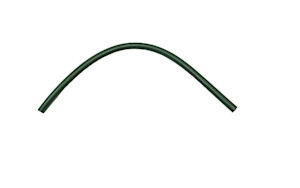
This DIY repair guide explains how to replace the fuel line on a log splitter. The fuel line carries gas from the fuel tank to the carburetor. A clogged, bent or cracked fuel line keeps the gas from flowing the engine, so the log splitter won’t start. Check the fuel lines and clear any clogs. Replace cracked or bent fuel lines using the manufacturer-approved log splitter part.
Use these steps to replace the fuel line on common Craftsman and MTD log splitters.
Quick links
Instructions
Tools required
Phillips screwdriver
Wrench set
Needle-nose pliers
Gas can (to hold fuel drained from tank)
Work gloves
Repair difficulty
Time required
30 minutes or less
Repair difficulty
Time required
30 minutes or less
Instructions
- 01.
Disconnect the spark plug wire
Disconnect the spark plug wire so there's no chance that the log splitter engine could accidentally start.
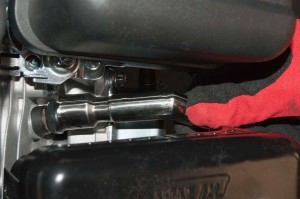
PHOTO: Disconnect the spark plug wire.
- 02.
Drain the fuel tank
Release the spring clamp that secures the fuel supply line to the fuel tank.
Disconnect the fuel supply line from the fuel tank and drain the fuel from the fuel tank into an approved container.
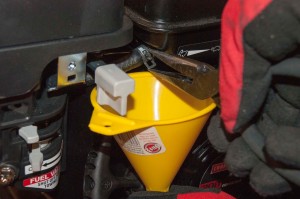
PHOTO: Drain the fuel from the fuel tank.
- 03.
Remove the air filter cover and air filter
Press the release tab on the air filter cover and lift the cover off of the engine.
Pull the air filter straight up and off the top of the silencer plate.
Tip: Clean the filter’s foam element if it’s dirty, following the directions in the owner's manual. Replace the filter elements if damaged.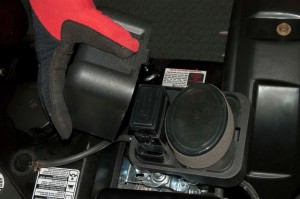
PHOTO: Remove the air filter cover.
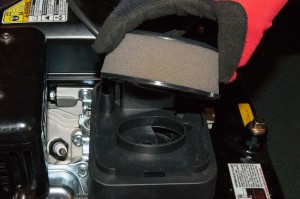
PHOTO: Pull the air filter off.
- 04.
Remove the silencer plate
Remove the two Phillips head screws securing the silencer plate to the top of the carburetor and remove the silencer plate.

PHOTO: Remove the silencer plate screws.

PHOTO: Remove the silencer plate.
- 05.
Remove the air cleaner housing
Remove the two 10-mm cap nuts that secure the air cleaner housing and the carburetor to the carburetor mounting studs.
Remove the 10-mm mounting bolt from the top of the air cleaner housing.
Disconnect the vent hose from the valve cover.
Pull the air cleaner housing off of the carburetor.
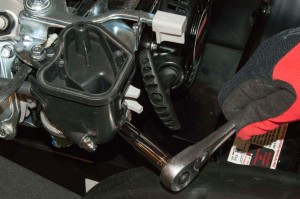
PHOTO: Remove the air filter housing mounting cap nuts.
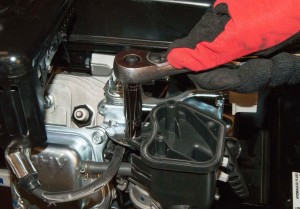
PHOTO: Remove the top bolt.
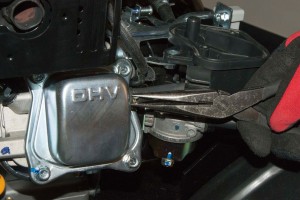
PHOTO: Disconnect the vent hose from the valve cover.

PHOTO: Remove the air filter housing.
- 06.
Remove the fuel line from the carburetor
Release the spring clamp from the fuel line connection on the carburetor and pull the fuel line off the carburetor.
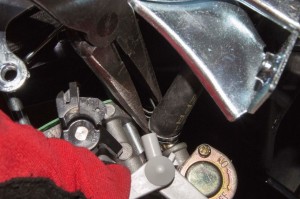
PHOTO: Disconnect the fuel line.
- 07.
Install the new fuel line
Position the spring clamps on the new fuel line so you can clamp the line into place when you connect it to the carburetor and the fuel tank.
Push one end of the new fuel line onto the connection on the carburetor and secure it with the spring clamp.
Push the other end of the fuel line onto the connection on the fuel tank and secure it with the spring clamp.

PHOTO: Install the new fuel line.
- 08.
Reinstall the air cleaner housing
Reinstall the air cleaner housing on the mounting studs and connect the vent hose on the valve cover.
Reinstall the 10-mm cap nuts on the ends of the mounting studs and tighten the cap nuts firmly.
Reinstall the 10-mm mounting bolt on the top of the air cleaner housing and tighten the mounting bolt firmly.
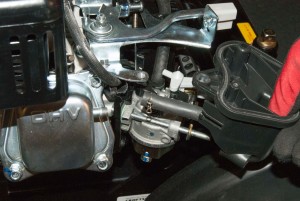
PHOTO: Reinstall the air filter housing.
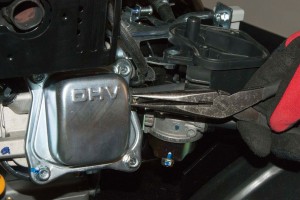
PHOTO: Reconnect the valve cover vent hose.
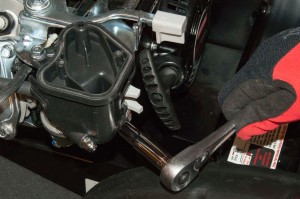
PHOTO: Reinstall the cap nuts.
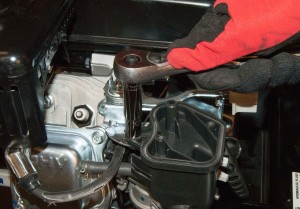
PHOTO: Reinstall the top mounting bolt.
- 09.
Reinstall the silencer plate
Reinstall the silencer plate on the top of the carburetor and secure the silencer plate with the screws.
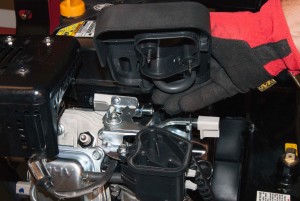
PHOTO: Reinstall the silencer plate.
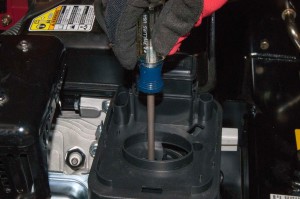
PHOTO: Reinstall the silencer plate mounting screws.
- 10.
Reinstall the air filter and cover
Push the air filter into place on top of the silencer plate.
Reinstall the air filter cover.

PHOTO: Reinstall the air filter.
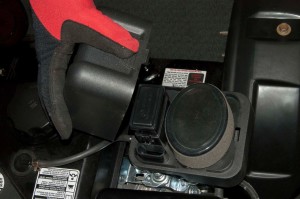
PHOTO: Reinstall the air filter cover.
- 11.
Fill gas tank with fuel
Fill the gas tank with fuel and check for leaks.
- 12.
Reconnect the spark plug wire
Connect the spark plug wire and test engine operation.
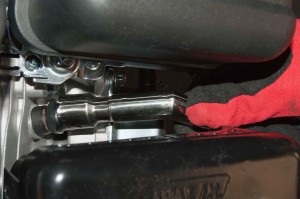
PHOTO: Reconnect the spark plug.
Warning: Undertaking repairs to appliances can be hazardous. Use the proper tools and safety equipment noted in the guide and follow all instructions. Do not proceed until you are confident that you understand all of the steps and are capable of completing the repair. Some repairs should only be performed by a qualified technician.
Most common symptoms to help you fix your log splitters
Choose a symptom to see related log splitter repairs.
Main cause: worn hydraulic valve seals around the actuator rod…
Main causes: broken pump coupler, clogged hydraulic fluid filter, bad hydraulic control valve, broken hydraulic pump, ba…
Main cause: worn hydraulic cylinder seals…
Main cause: worn hydraulic pump seals…
Main causes: leaky head gasket, damaged sump gasket, leaky oil drain plug, damaged fuel line, bad carburetor seals…
Main causes: dirty carburetor, bad spark plug, clogged air filter, stale fuel…
Main causes: dirty carburetor, stale fuel, bad spark plug, broken recoil starter…
Most common repair guides to help fix your log splitters
These step-by-step repair guides will help you safely fix what’s broken on your log splitter.
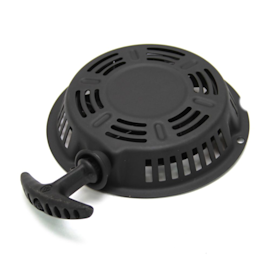
How to replace a log splitter recoil starter
The recoil starter spins the engine on the log splitter when you pull the starter rope, and the rope retracts when relea…
Repair difficulty
Time required
15 minutes or less
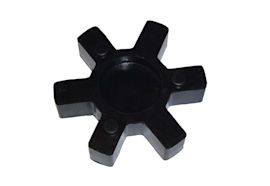
How to replace a log splitter flexible pump coupler
The flexible nylon log splitter pump coupler deteriorates over time. Replace the flexible pump coupler if it begins to v…
Repair difficulty
Time required
15 minutes or less
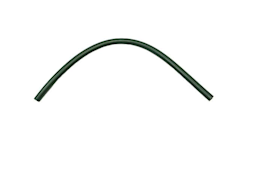
How to replace a log splitter fuel line
The fuel line carries the fuel supply from the gas tank to the carburetor. If the fuel line is cracked and leaking, repl…
Repair difficulty
Time required
30 minutes or less
Effective articles & videos to help repair your log splitters
Use the advice and tips in these articles to get the most out of your log splitter.
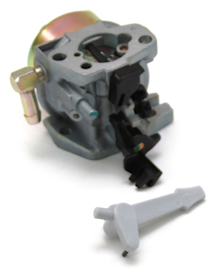
This chart will help you find the right carburetor for your Craftsman snowblower, tiller or log splitter.…
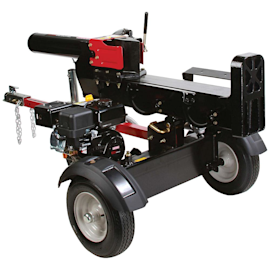
Learn more about your log splitter with these frequently asked questions.…
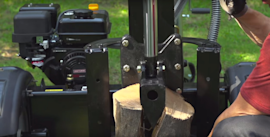
Learn how to change the hydraulic fluid in your log splitter.…